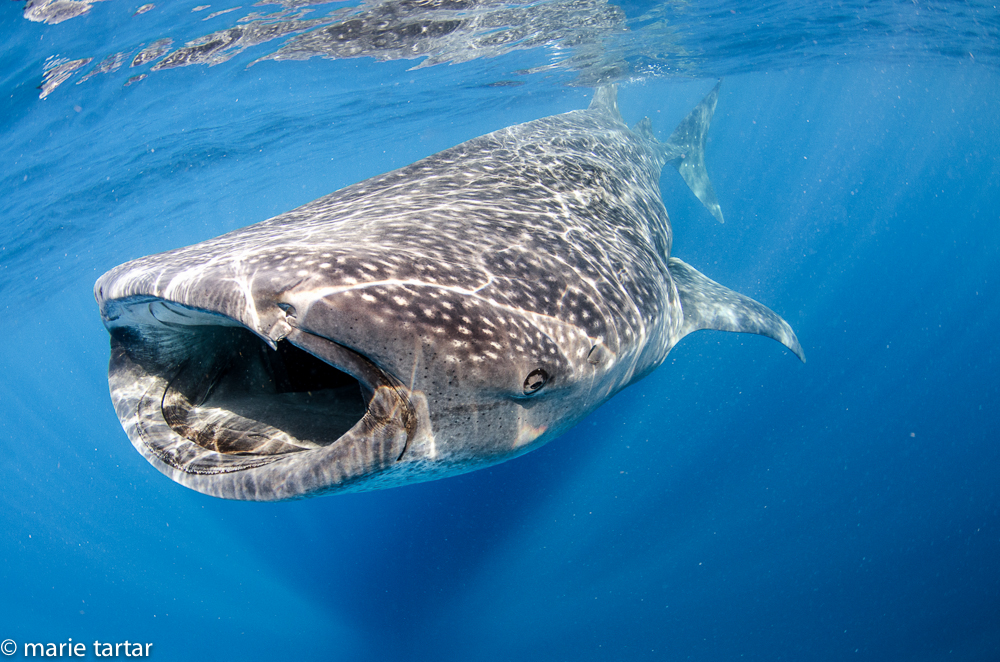
Until very recently, whale sharks had been a rather elusive photographic subject for us. Other than a 2 hour session of plane and panga-assisted hopscotch with a sizable specimen near La Paz, Baja California years ago, our prior whale shark encounters had been fleeting swim-bys, over almost as soon as the brain processed what was seen. We finally sated our whale shark lust in August, 2013.
We started early on a Saturday (7:30 departure to DFW) for our long planned stay on Isla Mujeres, a small (5 X 2 mile) island off the Yucatan peninsula, accessed by flying to Cancun, followed by a half hour drive to the Ultramar ferry terminal and finally, a 20 minute ferry ride. I had been hearing in recent years about reliable congregations of large numbers of feeding whale sharks found by fishermen in the waters off Holbox, and Isla Mujeres. So, when an offer for an exchange for a nice looking contemporary house on Isla Mujeres came our way, I jumped on it.
Since the house had 3 bedrooms and 2 baths, as well as a pool, it seemed a shame to keep it all to ourselves. Invitations to diving friends (Nancy and Gerry, Skip, Mark Strickland) yielded regrets, not enough interest, or other commitments. Our friend Greg Rothman committed quickly, and his friend Jill Salisbury was a later addition.
Finding a suitable boat operator took a bit of Internet detective work. It seems there is a plethora of boats for whale shark tours, but they all seemed geared to the casual snorkeling tourist, and not likely to yield the quality in water time needed for serious wildlife photography. The standard arrangement appeared to be 10 snorkelers, outfitted either in an adult equivalent of water wings (a bright orange flotation vest) or a wetsuit, with only 2 swimmers in the water at a time, accompanied by a guide. To me, this all added up to not enough in water time and possibly, many unwelcome inexperienced arms and legs in our shots (a scenario we had experienced in the Dominican Republic snorkeling with and photographing humpback whales).
Luckily, I stumbled on a very pertinent article in the Underwater Photography Guide by Stanley Bysshe, with tips and recommendations. As I feared, he indicated “tourist boats are not well suited for photography. They are crowded, have limited time in the water and you are surrounded by one hundred pairs of legs dangling in your line of site”. He went on to say “My research of Isla Mujeres found only one boat company that caters to photographing whale sharks.” Fortunately, he included a picture of the boat he went out on, the Lilly M, as well as a link to the parent company, Keen M International. Thus began my correspondence with Kin from Keen M, and with Mauricio Handler, one of the photo pros who runs trips each summer, resulting in the discovery that their boats were booked already, despite the fact I started in February! I made inquiries into joining a trip Eric Chang was running the same week, with the same result: sold out!
It became clear we would have to charter a private boat for ourselves, at $950/day, vs. the $125 per person tariff if we joined one of the tourist charters. This proved to be a good decision. The Lilly M itself was only available for Monday of our stay, but we could book a “panga” for additional days. The word “panga” meant to me little more than an uncovered Zodiac or a skiff, but I was reassured by Kin, who sent a picture of a reasonable looking covered vessel. We decided on 2 additional days, Wednesday and Thursday. The vessel we actually went out on, the Seahuahua, captained by Ruben and manned by Tito, actually proved faster and overall more comfortable than the Lilly M.
Kin hooked us up with a dive operator on the peninsula, Eco-Divers, who could introduce us to cenote diving. The Yucatan is laced with a network of limestone tunnels and caverns, filled with clear fresh water. The photos of light shafts streaming into caverns and interesting formations were intriguing. This would be a new diving experience for us.
Our travel day was uneventful until our arrival at Cancun Airport. I had splurged for first class tickets, which for some strange reason were only about 50% more than coach, rather than the usual 2X, 3X, or more premium (coach was $700 plus, first class was $1100). I had a few bad moments at the airport, realizing I had forgotten to print out the confirmation of our private roundtrip transport to and from the ferry terminal (www.BestDay.com; $90). Eventually, we connected with them and we were on our way.
On the ferry, we were serenaded by a willing, but not particularly gifted, guitar player, singing for tips. 20 minutes later, we were on Isla Mujeres. I had rented a golf cart for the week and made arrangements to pick it up in “el centro”. However, it was now well past 5 pm, when the office closed. I had the impression someone would be staying over until our arrival to connect us with our cart, but first we had to deal with paying for the boat charters. A few days before departure, Kin contacted me for credit card payment information (we made the arrangements so far in advance, we both may have forgotten I had never made any deposit). I had called her from work with the credit card number, later regretting that the one I had with me charges foreign transaction fees. On her end, the transaction wasn’t consummated, apparently due to our credit card company’s fraud alert. Despite Steve responding to texts and me to calls from the company to reassure them we were the ones making the transaction, by the day of our departure, it was clear we still were not paid up.
Accordingly, not knowing where to connect with the golf cart and needing to make good on our boat reservation, I directed the “maletero,” a man wielding a cart with a bicycle back, to take our overfilled cart to Hotel Media Luna (also owned by the boat operators), as we walked alongside. Unfortunately, it was at the far end of the centro, near Playa Norte. Once paid up, I hoped for help finding “Indios Golf Carts” from the hotel staff, but they were mystified. Eventually, I prevailed upon a helpful man at a nearby golf cart rental agency, who made a series of phone calls, eventually establishing that our golf cart awaited us at Casa de los Suenos, a hotel next door to our house. Hearing that, we had a taxi called (numero 33) and were finally on our way, the trunk gaping open with our luggage. As we approached the hotel, slowing for a speedbump (tope), a voice came out of the darkness “Villa Vista Azul?” Which was the name of the house and our actual destination. Two men lounged in the golf cart parked in our driveway, not overjoyed at the mix-up, but relieved we were finally there-at 8 pm! Apparently, they had gone to Casa de los Suenos when we didn’t make it to the office by closing, only to learn that no guests by our name were expected. It wasn’t until the man who called on my behalf reached them that they realized where we were actually staying.
We headed out on our maiden voyage in the golf cart to El Centro for a late dinner, to Villa Rolandi, a name we remembered from Cozumel. My seafood risotto was good. Steve ordered a pizza with tuna; however his pronunciation of atún sounded to the server like the name of a different pizza, “El Patron,” with prosciutto.
We spent Sunday morning organizing our gear and building our cameras, awaiting Greg and Jill, due in early afternoon. We went next door to Casa de los Sueños for lunch. The property is a beautiful small boutique hotel with an inviting infinity edge pool . The concierge took us for a tour, including the presidential suite. As we commented on the distinctive color scheme, she told us it was designed originally as a home for a French family by a Mexican architect whose name she couldn’t recall. “Barragán?,” we guessed. “Yes, that’s it!” (I don’t think this is the case. It looks like it could be designed by Ricardo Leggoreto.)
By now it was apparent that our plans to meet Greg and Jill at the ferry terminal in the golf cart would be curtailed by the size of the cart, which could hold 4 people and some luggage, but probably not enough. When Greg called to say they were en route, I told him to take a cab. As it happened, Jill’s bag had gone astray, so maybe we could have squeezed it all in.
While Jill took a nap to recover from her 2:30 am wake-up call to get to the airport in time, we headed into town to reconnoiter. First off, we needed to figure out where we would be leaving from-we didn’t want to be hunting in the morning when we’re supposed to be en route at 7:30 am. We were reassured we had the right place (the PEMEX dock, referring to the fuel station) when we found the boat docked there, the Lilly M.
Next, we need to locate some gear for Jill, in case they couldn’t provide for her on the boat. We end up heading to Playa del Norte where my Spanish language skills were tested by a friendly guard at the entrance to a hotel’s beach. His directions successfully take us on a tour of El Centro, past the church, past a lavandería named CienPieds, and to our target, a diveshop with rental gear. We didn’t end up needing it, but we did secure lanyards for our cameras during the hunt.
Despite not having her luggage, Jill was prepared with a bathing suit and toiletries, and we pieced together a near-complete set of gear for her between Greg’s and our back-up snorkels, masks, etc. The night before our first day on the water, I gave her my extra wetsuit to try on and was aghast when it appeared to be way too big for her, especially on top. I muttered, dejected, “I’m very muscular.” Hours later, I realized I had given her Steve’s identical but much larger extra wetsuit and mine actually fit her well, which was a relief for my self-image. I had emailed Kin about her needing fins and they were ready at the boat. Our departure was set for 7:30; we were early and we set off. Although not usually prone especially to seasickness, we had been forewarned and were wearing Scopolamine patches (Greg a full dose, Steve and I ½ each, good for 3 days).
Only a couple of other boats were there when the engines slowed. Our excitement mounted as we saw whale shark fins breaking the surface all around us, first on this side of the boat, then the other. It was hard not to hyperventilate with anticipation as we suited up.
And even harder to calm down after slipping into the water! It was hard to know which way to look, but mindful of advice received from other photographers, I tried to concentrate on keeping the sun to my back. Even that is easier said than done. The first few times a whaleshark swept my way, I reflexively squeezed the trigger, click, click, click, at 5 frames/second, forgetting at first to even look through the viewfinder. We had debated the merits of angled vs. straight viewfinders, eventually opting to go with the angled, since we and the whalesharks would largely be on the surface. Getting the viewfinder precisely aligned with one’s eye, especially with so much going on, was surprisingly challenging as well. In the time between seeing a huge form take shape at the edge of perception to the time to find it in the viewfinder, it seemed to loom in front to submarine size.
Which way to look? Pop one’s head up and head in the direction of the nearest fin breaching the surface? Strain one’s eyes into the void, imagining shadows are approaching whalesharks? The dancing light plays tricks on the eyes. But we didn’t have to wait long. About the time I considered repositioning, a whaleshark, no two, no three would materialized and sweep toward the surface, bigger than life. I learn to expect a whaleshark to materialize from the blue if I saw a lone remora, sometimes two, like sentinels, traversing the blue. It seemed frequently they heralded the coming of their host, “Mr. Big,” shortly after.
It is surprising, but even a huge animal like a whaleshark can seem to “sneak up” and suddenly just BE THERE. More than once, I looked down to realize a whaleshark was cruising just a few feet below me, making me feel I was on the verge of being lifted out of the water by a submarine or UFO. Being filter feeders, there is nothing to fear in terms of being targeted as a food source. The mouth is so large that being engulfed in it is theoretically possible, but thankfully, the esophagus reportedly is too small to admit a human, so presumably one would be promptly ejected.
It is intimidating being next to such a large animal. The underwater photographer’s mantra, (Get close, then get even closer), applies here. With the wide angle lenses necessary to shoot such a big creature (I used 10-17 mm), they look tiny in the viewfinder until you are really CLOSE. At that point, the animal seems transformed into an oncoming train.
Once the head has passed, avoiding being struck by the tail is paramount. I don’t personally know of anyone being seriously injured by a whaleshark, but if spooked, it seems possible. Two weeks before a similar humpback whale snorkeling trip we did years back in the Dominican Republic , a protective humpback mother of a too closely approached calf delivered a concussion to one swimmer and a fractured femur to another, with one tail flick.
The whalesharks most frequently are cruising just below or toward the surface. Attempting to swim alongside one renders one quickly breathless. Rather, it seemed more productive to hang out, back to the sun, and wait until one swam toward you, then try to be ready and in good position to catch a series of frames as it swept past. Steve and I lucked out our last day, finding what the Mexicans call a “botella” (bottle); that is, a whale shark feeding upright, and not actively swimming. Our botella seemed to twirl in the water column, giving us both the opportunity to freedive at the same time, yielding a favorite image of the trip, now Steve’s new Facebook profile picture:
Rogelio and Juan on the Lilly M, and later Ruben and Tito on the Seahuahua, made no attempt to accompany us into the water or to curtail our time. The big cameras or maybe the fact we never looked back to even find the boat until a couple of hours had passed seemed assurance enough to them that we knew what we were doing. We climbed back aboard when we wanted to rest, warm up or eat, lunch usually being ceviche made on board. We would head back some 6 hours later, leaving us the afternoons to download, pick up cocktail provisions at the CHEDRAUI store between the house and the dock, and put Greg’s recently completed mixology course to the test. One of the innovations of that week of experimentation: the new improved gin and tonic, topped with fresh grapefruit pulp-deliciosa!
What is the apparent draw for these behemoths to these waters in summer seems to be a high concentration of microscopic morsels, namely fish eggs. Research indicates the source is spawning Little Tunny, aka Bonito or small Atlantic Tuna. What is really surprising is how recently this whale watching industry has sprung up, in the last 10 years. Prior to that, it wasn’t unusual for motivated marine photographers to travel great distances for whale shark encounters. One of the more well known of these destinations is the Ningaloo Reef, near Perth, in Western Australia. It seems this much closer-to-home aggregation had been known to generations of Mexican fishermen, but was not known by researchers and the broader diving public until very recently. By the time we were spent and ready to head in, we found ourselves in a flotilla of boats, perhaps 70 or so, some coming from Cancun.
We had scheduled Monday and Tuesday as whale shark excursion days, Wednesday to cross back to Cancun to try cenote diving, and Thursday as another whale shark day, leaving Friday as an unscheduled day. Our thinking was we should have good whale shark results after 3 days, but would have a free day as insurance, in cause nothing was happening, always a risk with wildlife encounters. No guarantees-even the Keen M staff’s T shirts say “No whining.” Or maybe we would be so enthralled with cenote diving that we might want to do a second day. What actually happened…we had tons of great whale shark encounters, not to mention manta interactions, and more shots than we could have ever imagined after 3 days. All 3 days were very productive, just exhilarating, breath-taking, so much so we would have done another day, if a boat had been available. Not so much that we needed more shots, but more for the sensation of amazement…overwhelming and priceless.
We did love our day trip to Playa del Carmen and our first cenote dives, at Chikin Ha, with Victor as our guide. What we didn’t love was the amount of time it took to ferry back over to Cancun and make our way to Playa del Carmen. Victor picked us up, gathering tanks, equipment and lunch en route, probably a trip of 1.5 hours each way. It was a great introduction. 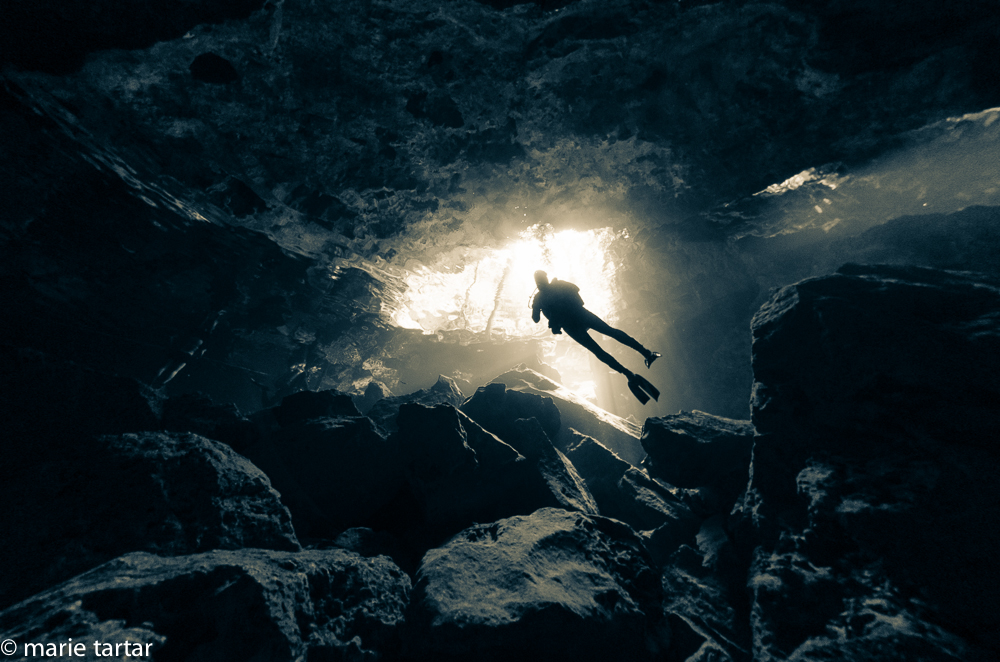 The eerie sensations of being in such a clear, fresh water cavern, alternately dark and flooded with light, were intoxicating in their own way and strengthened our resolve to return and dive more cenotes, next time staying in Playa del Carmen itself (which we did, see blog February 2014).
The eerie sensations of being in such a clear, fresh water cavern, alternately dark and flooded with light, were intoxicating in their own way and strengthened our resolve to return and dive more cenotes, next time staying in Playa del Carmen itself (which we did, see blog February 2014).
We spent our final free day touring around the island, finding a sculpture park at the southern tip. There also is a tortugranja (Turtle Farm) off the west coast which is interesting to visit. 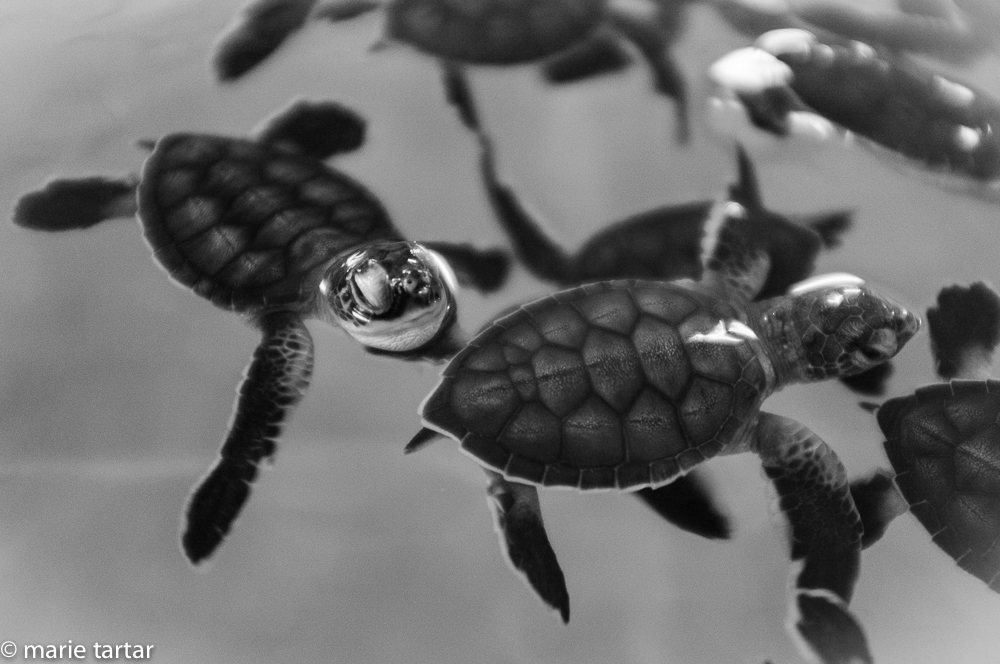 We finally had a chance to try a restaurant we had scouted on prior days, the Mango Cafe. We liked it so much we returned the next morning for our final breakfast before heading back on the ferry to Cancun and the airport and going our separate ways, already planning a return the following year, to try for shots of another signature local species, the sailfish.
We finally had a chance to try a restaurant we had scouted on prior days, the Mango Cafe. We liked it so much we returned the next morning for our final breakfast before heading back on the ferry to Cancun and the airport and going our separate ways, already planning a return the following year, to try for shots of another signature local species, the sailfish.
Advice from Shawn Heinrichs:
Advice:
– fisheye lens
– 200-250 shutter min
– higher ISO to get good aperture
– fixed focus (on fin or close by swimmer)
– sun at back…hugely important here
Reference info:
Keen M International Sección Rocas, Punta Norte, Lote 10, Int. B2 Isla Mujeres, Quintana Roo 77400, Mexico 011 52 (998) 877 0759 011 52 (998) 877 1124 www.islamujeressportfishing.com fishkinm@cancun.com.mx
José Castelazo
+52 (984) 879-4716
Playa del Carmen, México.
Jimbo Rusley
Reservations@IslaMujeresGolfCartRentals.com
www.IslaMujeresGolfCartRentals.com
Next time: reserve extra large cart with gear carrying rack
roundtrip transportation to Ultramar ferry from Cancun airport:
www.BestDay.com; $90 (private van)
Idea pour la proxima vez: Isla Contoy
Si hay varias embarcaciones que salen desde Isla Mujeres, la empresa que te puedo recomendar es “El Sol”, ellos estan ubicados Av. Benito Juárez M.3, N.20, en el centro de la isla, entre Matamoros y Abasolo; su teléfono es 877 07 91.


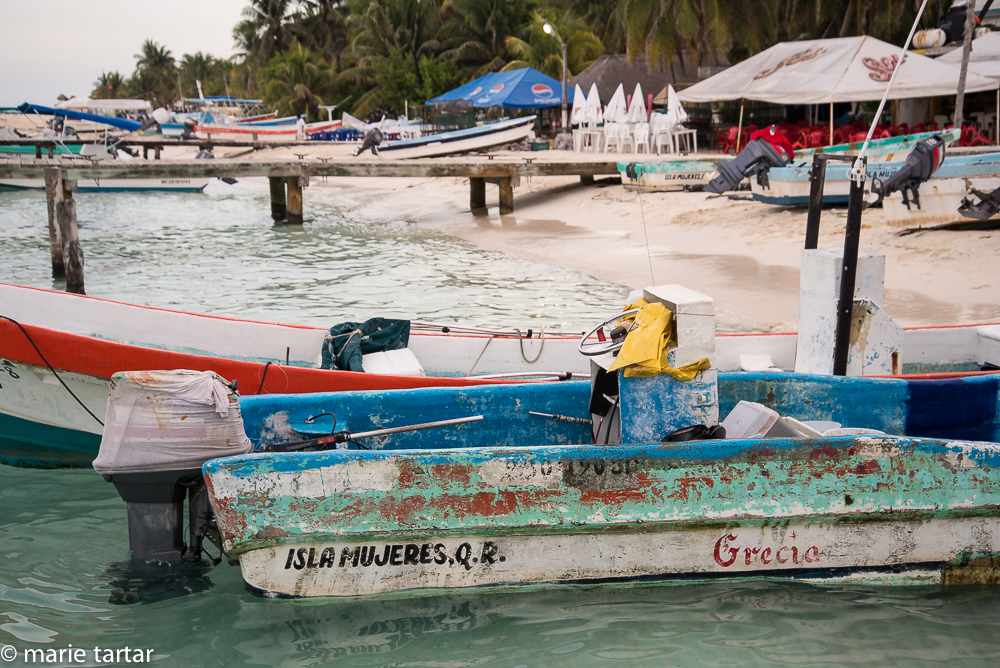


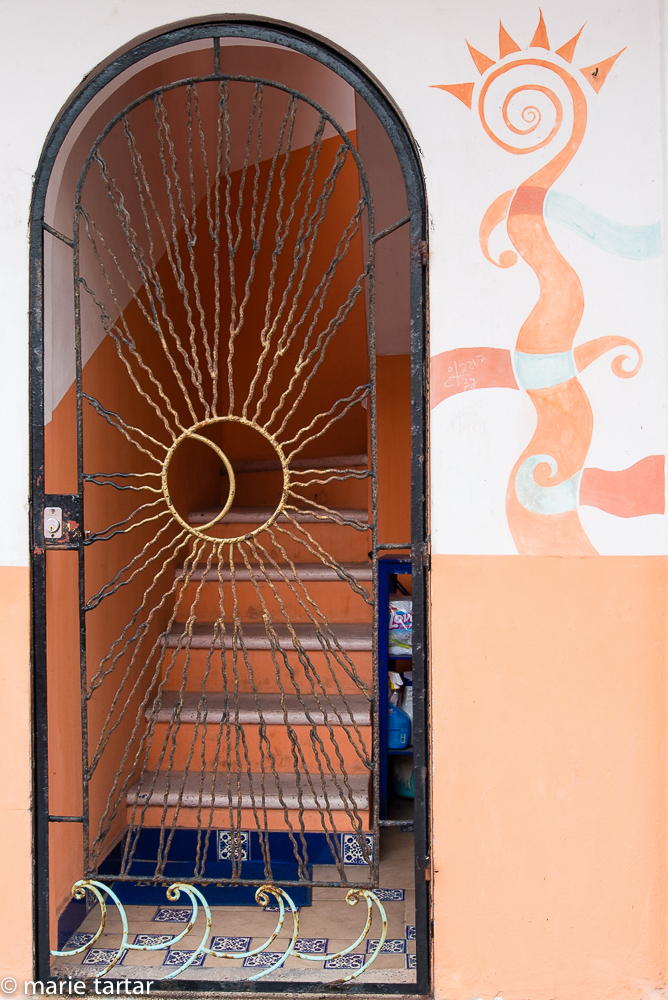

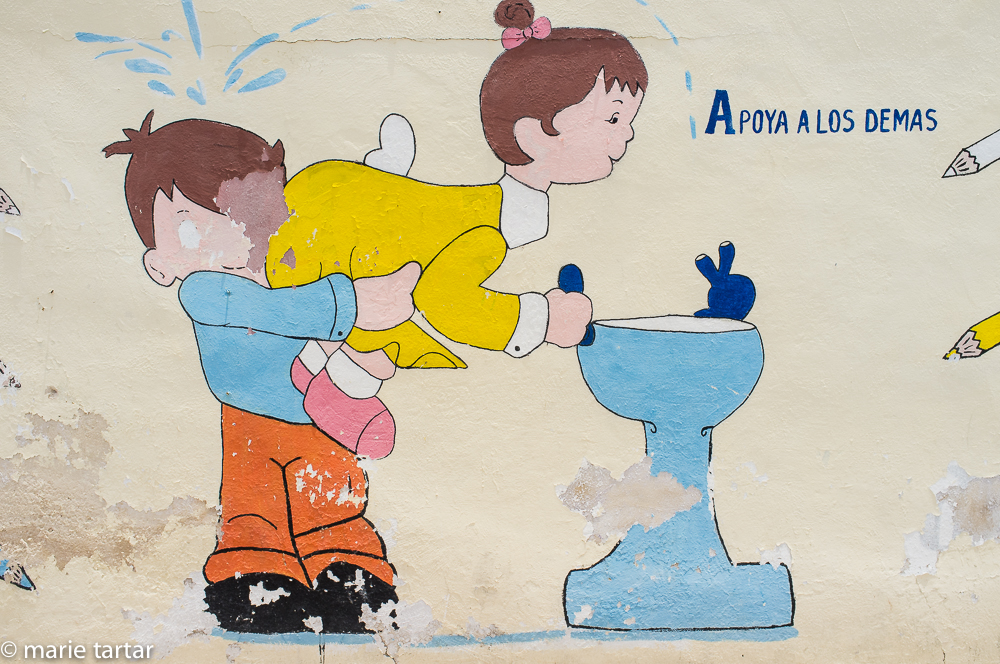
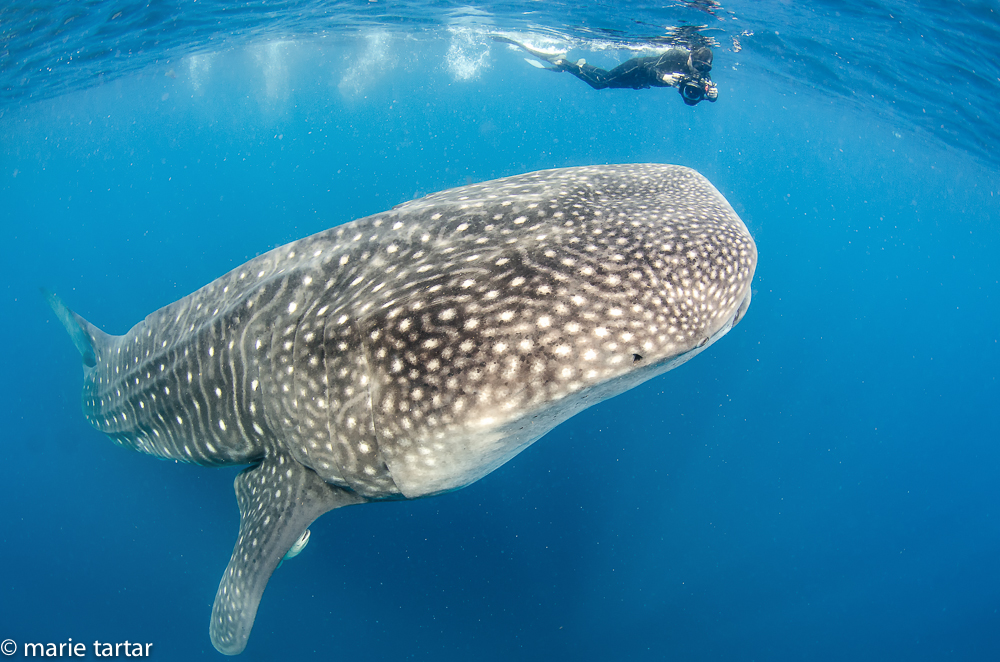


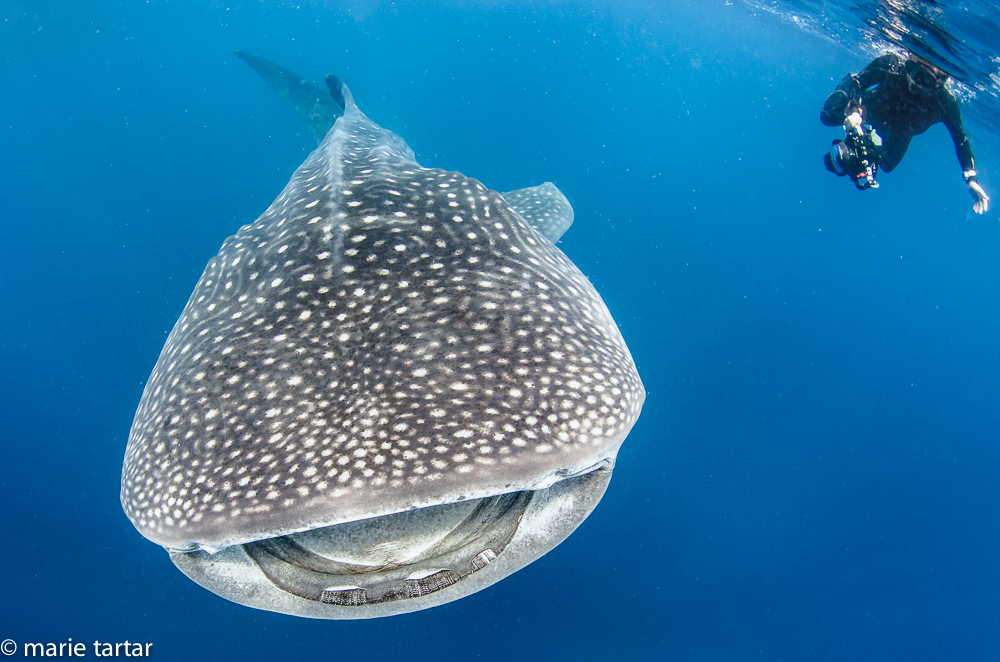
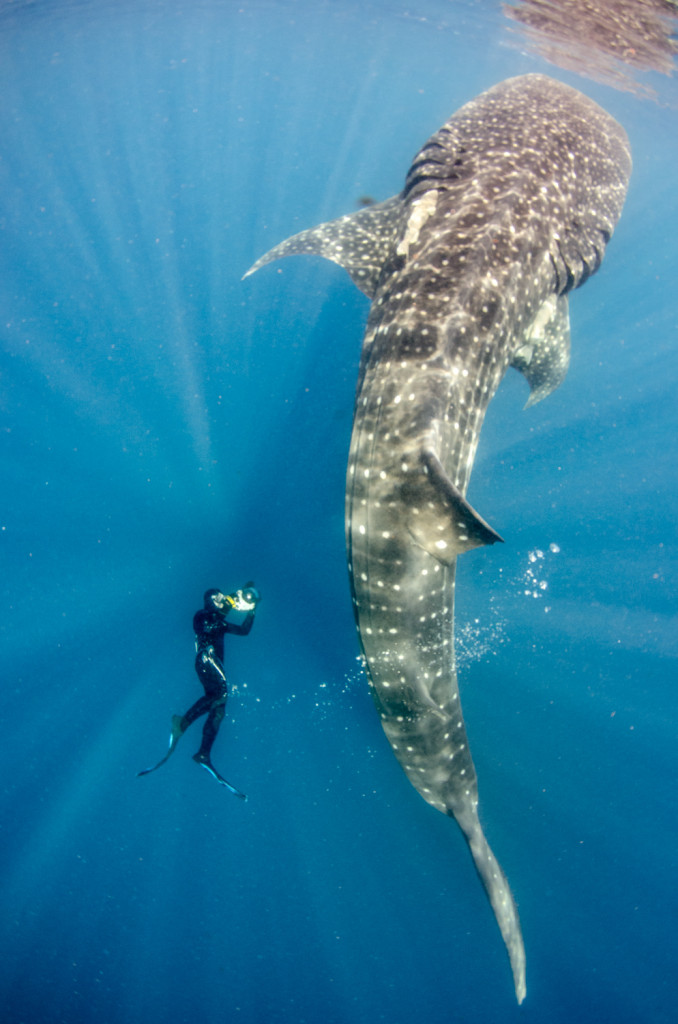
Trying to get a hold of the Lilly M as my friends did an amazing Whale Shark adventure with you and I am coming next week and would love to see a Majestic Whale Shark? Thanks Laurie 310)200-6988